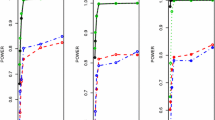Abstract
In this paper, we introduce a new method to test whether a discrete-time periodically correlated model explains an observed time series. The proposed method is based on the estimation of the support of spectral measure. Comparisons between our procedure and the methods which were proposed by Broszkiewicz-Suwaj et al. (Phys A 336:196–205, 2004) show that our testing procedure is more powerful. We investigate the performance of the proposed method by using real and simulated datasets.



Similar content being viewed by others
References
Anderson PL, Meerschaert MM (2005) Parameter estimation for periodically stationary time series. J Time Ser Anal 26:489–518
Anderson PL, Meerschaert MM, Vecchia A (1999) Innovations algorithm for periodically stationary time series. Stoch Process Appl 83:149–169
Benjamini Y, Hochberg Y (1995) Controlling the false discovery rate: a practical and powerful approach to multiple testing. J R Stat Soc Ser B 57(1):125–133
Billingsley P (1995) Probability and measure, 3rd edn. Wiley, Hoboken
Bloomfield P, Hurd HL, Lund R (1994) Periodic correlation in stratospheric ozone time series. J Time Ser Anal 15(2):127–150
Broszkiewicz-Suwaj E (2003) Methods for determining the presence of periodic correlation based on the bootstrap methodology. Hugo Steinhaus Center research report HSC/03/2. http://www.im.pwr.wroc.pl/~hugo/Publications.html
Broszkiewicz-Suwaj E, Makagon A, Weron R, Wylomanska A (2004) On detecting and modeling periodic correlation in financial data. Phys A 336:196–205
Franses PH (1996) Periodicity and stochastic trends in economic time series. Oxford University Press, New York
Gardner WA, Franks LE (1975) Characterization of cyclostationary random signal processes. IEEE Trans Inf Theory IT–21:4–14
Gardner WA, Napolitano A, Paura L (2006) Cyclostationarity: half a century of research. Sig Process 86:639–697
Gladyshev EG (1961) Periodically correlated random sequences. Sov Math 2:385–388
Holm S (1979) A simple sequentially rejective multiple test procedure. Scand J Stat 6(2):65–70
Hurd HL, Gerr N (1991) Graphical methods for determining the presence of periodic correlation in time series. J Time Ser Anal 12:337–350
Hurd HL, Miamee AG (2007) Periodically correlated sequences: spectral theory and practice. Wiley, Hoboken
Mahmoudi MR, Nematollahi AR, Soltani AR (2015) On the detection and estimation of simple processes. Iran J Sci Technol A(39):239–242
Nematollahi AR, Soltani AR, Mahmoudi MR (2016) Periodically correlated modeling by means of the periodograms asymptotic distributions. Stat Pap 1–12. doi:10.1007/s00362-016-0748-9
Nord Pool Annual Report (2002) Nord pool ASA
Soltani AR, Azimmohseni M (2007a) Periodograms asymptotic distributions in periodically correlated processes and multivariate stationary processes: an alternative approach. J Stat Plan Inference 137:1236–1242
Soltani AR, Azimmohseni M (2007b) Simulation of real-valued discrete-time periodically correlated gaussian processes with prescribed spectral density matrices. J Time Ser Anal 28(2):225–240
Soltani AR, Parvardeh A (2006) Simple random measures and simple processes. Theory Probab Appl 50(3):448–462
Storey JD (2002) A direct approach to false discovery rates. J R Stat Soc Ser B Stat Methodol 64:479–498
Storey JD, Tibshirani R (2003) Statistical significance for genomewide studies. Proc Natl Acad Sci USA 100:9440–9445
Strimmer K (2008) fdrtool: a versatile r package for estimating local and tail area-based false discovery rates. Bioinformatics 24:1461–1462
Vinod HD, Lopez-de-Lacalle J (2009) Maximum entropy bootstrap for time series: the meboot R package. J Stat Soft 29(5):1–19
Acknowledgements
We would like to express our very great appreciation to associate editor and reviewer(s) for their valuable and constructive suggestions during the planning and development of this research work.
Author information
Authors and Affiliations
Corresponding author
Rights and permissions
About this article
Cite this article
Mahmoudi, M.R., Maleki, M. A new method to detect periodically correlated structure. Comput Stat 32, 1569–1581 (2017). https://doi.org/10.1007/s00180-016-0705-z
Received:
Accepted:
Published:
Issue Date:
DOI: https://doi.org/10.1007/s00180-016-0705-z




